This is the sixth in a series of educational articles about heraldry in Calontir.
Previously, we discussed inspiration and general principles for your coat-of-arms. Now lets look at the key ingredients.
Tinctures
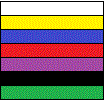
“Tincture” is the term heralds use for color. There are seven standard tinctures used in heraldry. Technically, the term “color” is only for the darker colors: blue, red, purple, black and green. The term “metal” is used for the light colors: white and yellow (aka silver, gold). The only time we can use other colors like orange or brown is if they’re the natural color of the object, such the wooden handle of a hammer.
Contrast
Identifiably requires good contrast, so we need to avoid putting dark things on a dark background (color-on-color) and light things on a light background (metal-on-metal).
Layers.
The 1st layer of your design is the background. Heralds call it the field. It is possible to have a coat of arms that is just a field!
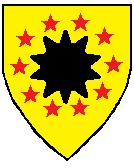
The 2nd layer is made up of the primary, secondary, and/or peripheral charges.
Primary charges are the main motif/s in the central area of the shield, whether a stripe down the middle or a dozen caltrops scattered on the field.
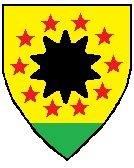
Secondary charges are motifs around the primary charge, for example a circle of stars around a sun. This gets tricky, because that same circle of stars becomes the “primary charge group” if we remove the sun from the design.
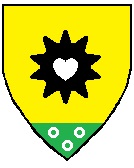
Peripheral charges are motifs that are part of the edge of the shield such as a border or, in this case, a base. They can never be a primary charge because they can never be in the central area of the shield. It is possible to have a coat of arms that only has peripheral charges on the field, so they are different from secondary charges.
The 3rd layer is made up of the tertiary charges. Tertiary charges are motifs that are layered on other motifs, such as rings on a base or a heart on a sun. [Quaternary charges are not allowed.]
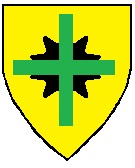 Overall charges are special. They’re a bit like overgrown tertiary charges that overlap the field. They have weird rules because of that, and it’s hard to make good designs with overall charges – they have to overlap the field enough, they can’t cover up too much of the other charges, etc. In this case, it’s hard to see that there’s a sun hiding underneath the cross.
Overall charges are special. They’re a bit like overgrown tertiary charges that overlap the field. They have weird rules because of that, and it’s hard to make good designs with overall charges – they have to overlap the field enough, they can’t cover up too much of the other charges, etc. In this case, it’s hard to see that there’s a sun hiding underneath the cross.
If this is starting to get confusing, there are lots of resources to help. See “Heraldic Helpers“, come meet us at a consult table near you, or try out the Virtual Consult Table!
At your service,
Sofya la Rus, Habicht Herald
Calontir Heraldic Education Deputy
habicht@calontir.org

You must be logged in to post a comment.